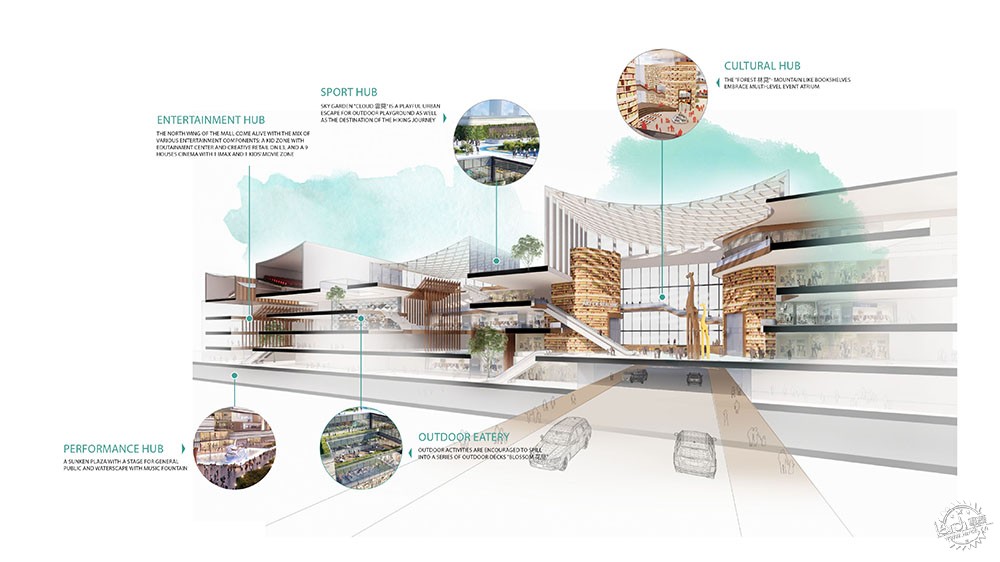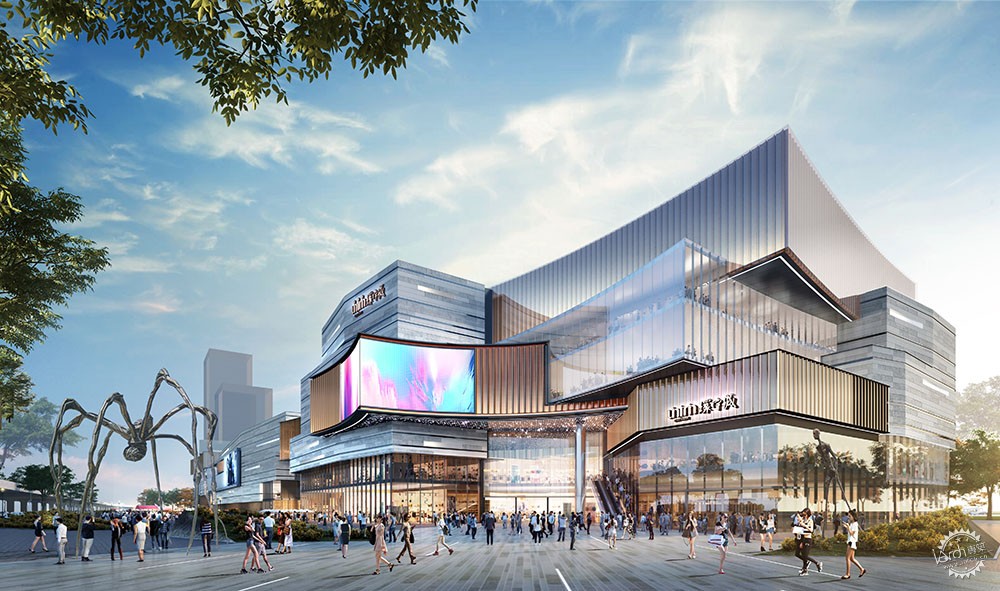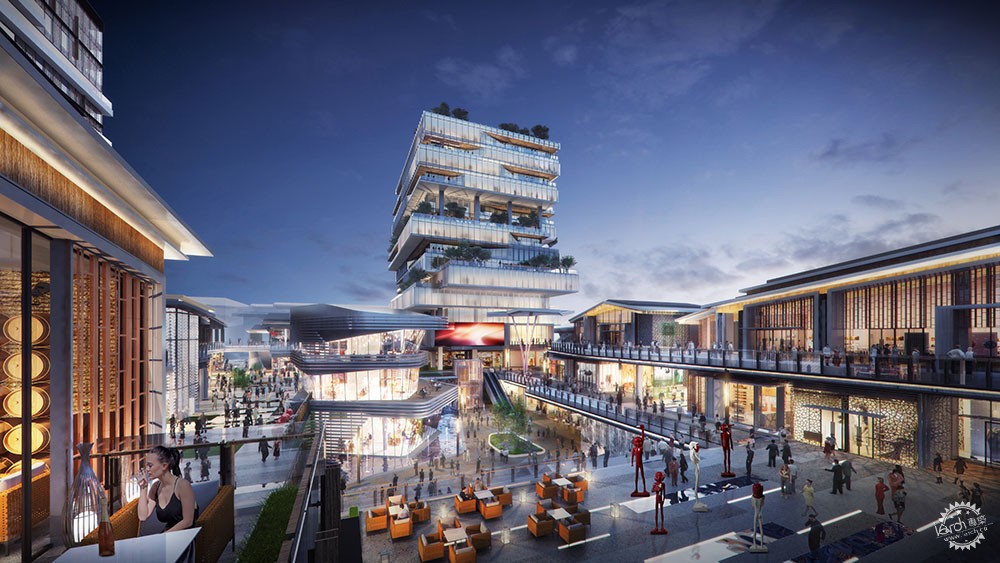
中国石家庄正定里综合项目设有步行区,建立人与人的联系,并制造许多“不期而遇”和“美好回忆”/Zhengding Li Mixed-use Development in Shijiazhuang, China offers pedestrian-friendly retail streets to connect people and create ‘serendipities’ and memories/
未来的零售空间会变成怎样?设计将如何影响未来生活模式以及人与地方之间的互动关系?
商业市场竞争激烈,零售品牌及商场业主面对不同的挑战,包括来自电子商贸、消费模式转变以及经济不确定性等等。零售业者已开始重整店铺经营政策,而不单靠产品方面取胜。LWK + PARTNERS 四位商业及综合设计团队成员包括总经理黄谷和刘晓冬、以及总建筑师陈俊宇和黄元任进行了一场圆桌对话,以他们丰富的经验一起探讨了零售商业的未来发展,以及构建空间时的各种考量。
怎样才是成功的商业空间?
黄谷︰首先,成功的商业空间必需拥有强大的社交聚合功能,把人连系起来,商户组合条理分明,提供特色空间体验。这个地方能够回应人的情感所需,激荡人心,为享用空间的过程赋予意义。场地的硬件(环境)和软件(公共空间品质、商户组合等)必须互相配合,包括拥有清楚易读、容易理解的空间导向系统。
黄元任︰对我来讲,一个出色的商业空间能够给访客创造集体回忆。无论是主题也好、气氛也好,让人谈论这个空间的时候,言谈间会出现共同的回忆和体验。要达到这个效果,所需要的元素往往因地方场景而异,例如夜行消费的模式,虽然能在某些地方风行,以致发展商可以选择采用某种发展策略及空间布局,却不能应用到所有地区。
What do future retail spaces look like? What possibilities can design offer to people’s future ways of living and their relationship with places?
In a fiercely competitive market, retailers and landlords are facing challenges from e-commerce, changing consumption patterns and economic uncertainties. Brands have started rethinking their store operation strategies on top of product offerings. We sat down with four colleagues from LWK + PARTNERS Commercial & Mixed-use Team, including Associate Director Erica Wong and Louis Liu, as well as Senior Associate Keith Chan and Samuel Wong, to discuss the future of retail and what’s important to them when creating places for people.
Let’s start with what you think makes a successful retail space.
Erica: A successful retail space should first be a strong social connector that draws people together, with a sensible retail mix and offering them a unique spatial experience. It would address the emotional needs of people, reaching into their hearts and minds deep and full, making the visit meaningful for all. This results from a combination of hardware (the environment) and software (quality of public space, tenant offerings). Legibility and wayfinding are vital, and any elements need to be self-explanatory.
Samuel: For me, it’s important for retail spaces to strike a collective memory for visitors. A theme, a vibe, whatever you call it, it’s something that everyone can relate to and be able to talk about it when recalling their experience of the place. What works in one place may not work in another. Late-night consumption, for example, though not a new phenomenon, is quite specific to some parts of the world, and this has made certain development strategies and spatial structures possible in one place but not another.


去年 12 月开幕的中国杭州紫荆天街,启发自中国艺术中的「留白」概念,鼓励访客发挥自由想像/The design of Zijing Paradise Walk, which opened in Hangzhou, China in December 2019, was inspired by the Liubai concept in Chinese art, deliberating leaving out blank spaces to encourage the viewer’s imagination
陈俊宇︰建筑当为人服务。成功的商业空间,就是让每一个人各取所需,活得更好。那是一个人人畅达无阻的空间。LWK + PARTNERS 希望能做到的就是鼓励人们探索身边的事物,发掘生活中的美好。以刚刚开幕的杭州紫荆天街为例,其建筑设计从当地家传户晓的徽派建筑吸取灵感,加插现代元素以完善动线设计,创造出崭新、以人们的身心健康为导向的生活模式。
刘晓冬︰成功的空间需吸纳邻里社区的本土元素,包括产业架构、生活方式、人口结构、街区景观等等。在中国某些地区,商场建筑在本质上就为该区带来新的天际线元素,但新建筑的存在并不代表需要与当地生活相互违背,而是更应该透过设计,从密度、视界、绿化、步行性以及交通等方面,令城市元素变得丰富多彩。
Keith: Architecture is always about serving people. A successful retail space is where everyone can find their needs catered and a place that helps people live better lives. A place accessible for everyone. What we’re trying to do is to encourage people to discover the kinds of beauty in life that many of us can relate to. Take the recently opened Hangzhou’s Zijing Paradise Walk in China as an example. Its design extracts iconic features from the Hui-style architecture, which the local population can easily identify with, and adds a modern twist to its circulation design to encourage a new kind of wellness-driven lifestyle in Hangzhou.
Louis: The space must integrate with existing elements of the neighbourhood, including the economic structure, people’s lifestyle, demographics and streetscape. In some parts of China, the shopping mall typology itself may form a new landscape for the city, but instead of compromising local ways of life, new lifestyle complexes must be designed to complement existing urban features, in terms of density, sight, greenery, walkability and transport connections.


紫荆天街以徽派建筑为基础,对空间进行层叠及挖空,增添现代色彩/Zijing Paradise Walk adds a modern twist to local Hui-style architectural features by using multi-layering and carve-out treatments of space.
与各大商业发展商合作多年,观察到什么需求上的转变?与消费模式转变有何关系?
刘晓冬︰当前的零售商业正面临电子商贸的冲击,发展商及商家都在绞尽脑汁,尽量善用线上平台带来的商机。但是实体店铺并没有消失的迹象,目前也不乏以新的营商手法结合线上线下平台的成功案例。消费模式确实变了,而发展商也心中雪亮。人们追求的不仅仅是一个消费购物的好去处,而是追求无形的“收获”,而到访商场的动力也从纯粹购物转移到生活体验、知识分享和社交互动。
黄谷︰这大概就是我们所说的“后消费主义”。就你刚才所说的无形“收获”,这正正就是我们在设计中国济南华山西环宇城时,为何要这么用心创造社交互动和空间转换的体验。我们希望人们到来发掘生活新点子,甚至与亲友分享,我们制造生活惊喜、偶遇,甚至如日本文化中所说的“一期一会”。
You’ve all worked with major retail developers for many years. Are there any changes in their needs over the years? How is this related to changing consumer patterns?
Louis: We live in a time where the retail industry is pressured by the prevalence of e-commerce. Developers and their retail tenants are rethinking their strategies to embrace online platforms, whilst brick-and-mortar environments are not going away at all. In fact, there are examples where new business models that integrate online and offline platforms are proving extremely successful. Consumption patterns have certainly changed, and developers recognise it. People look for more than a place to shop and spend, and they are looking for intangible ‘takeaways’. The motivation of their visits has shifted from shopping to experiencing, knowledge sharing and social gathering.
Erica: I guess this is what we call post-Consumerism. Related to what you said about people looking for intangible ‘takeaways’, it’s exactly why we’ve put in so much thinking into catalysing social interactions and movement between spaces in West Huashan Unipark in Jinan, China. We want to make it a place where people come to discover new, life-enrichening ideas that they want to share with family and friends after the visit. We want to create ‘serendipities’, or a once-in-a-lifetime encounter like the Japanese saying.


中国济南华山西环宇城利用交错的室内外空间,加上层次丰富的元素和公共空间, 打造活力综合体,让访客得到无形“收获”/Intertwining indoor and outdoor areas, together with a diversity of stimulating elements and communal spaces, will make Jinan’s West Huashan Unipark in China a dynamic hub for people looking for intangible takeaways
黄元任︰我们观察到发展商管理层也越来越重视公共空间,更乐于为周遭社区提供高品质的社交活动空间。预计明年落成的中国杭州奥体万科中心是一个新型办公综合体,当中包括一个商业裙楼,由层递式开放平台包裹着,透过独特的设计手法,逐层旋转,令每层的开放程度各异,自成一个独特的空间,帮助人们尤其是上班族开拓与不同人交谈的机会。中国发展商对于全新的开发模式持非常开放的态度,在项目设计层面的讨论也很开放和互动。
Samuel: We’ve also seen a rising concern for public spaces among the management of developers, who are increasingly conscious about offering quality social spaces for the surrounding neighbourhood. At Olympic Vanke Centre, a new-style office complex in Hangzhou, China with a retail podium which we expect to complete next year, public spaces are set out in very diverse forms. The retail podium will be wrapped around by cascading open terraces, enabled by a special design feature – we rotate every floor of the podium to make the terraces slightly different from one another, allowing different degrees of publicness at the same time. We expect to create a whole new layer of networking opportunities there, especially for the office users. Chinese developers are very receptive towards new ways of carrying out their projects, and discussions on project design has become more open and interactive.


中国杭州奥体万科中心拥有非常多元化的公共空间,分布于不同楼层,形式包括裙楼平台、屋顶花园等/Public spaces are set out in very diverse forms and sprinkled across levels from podium terraces through to rooftop gardens at Olympic Vanke Centre in Hangzhou, China
黄谷︰不止是发展商,其实消费者对日常聚会、与人互动及休闲的空间,也呈现出越来越高的敏感度,比以往更渴求与其他人,甚至与地方,建立联系。人们更希望认识一个地方的前世今生,了解场地如何从原来的用途发展成今天的建筑,甚至对周遭空间的结构亦感到好奇。这就解释了透明度和可视性对今天建筑何其重要。所谓地方营造,就是对身处的空间建立认知,透过理解与其他人及空间之间的关系,理解自己立足点。从事空间设计的我们,就在这个过程中推波助澜,鼓励人们感受和了解周遭环境。
Erica: Adding to your point about public space – I think not only developers, but consumers are also increasingly sensitive about the quality of spaces available for them to casually meet, interact and hang around. More than ever, people crave to be connected. Not only with people, but with places. They want to understand the legacy of a place: how the site was originally used, how a new development comes into place. Visitors even want to be informed of the structure of the place they’re in, and that’s why transparency and visibility are so important for today’s architecture. Placemaking is about understanding where you are, in relation to other people and places. As designers of places, we are facilitating that process of exploration, encouraging them to take in and understand their surroundings.

地方营造,就是理解与其他人及空间之间的关系,而建筑可以透过可视性和室内外空间交错来建立这个联系。华山西环宇城从附近的地势撷取灵感,营造浸入式体验/Placemaking is about understanding one’s relationship with other people and places. Visibility and the interplay of outdoor and indoor spaces are ways to establish such connections. At West Huashan Unipark, visitors are immersed in a landscape-inspired environment extending from the nearby mountains
我们经常谈到“体验”,但其实是一个挺难捉摸的概念。在商业语境中,我们要如何定义它?我们如何设计“体验”这回事?
黄元任︰没错,追求“体验”的过程确实有个比较实际的商业面向。以体验为导向的设计方式,似乎可以同时满足新世代最终用家的需求,以及发展商和零售商的商业需要。消费者需要新的动机进行线下购物,过程中他们期望得到比纯商品更多的东西。同时,商业设施需要可行而有创意的方式来吸引访客并从市场竞争中脱颖而出。
We talk about ‘experience’ a lot and it is such an elusive concept. But how do we define it in commercial terms? How do we design experiences?
Samuel: True, there’s a practical aspect to the quest for ‘experience’. It seems that the experience-oriented design approach serves to satisfy both new-generation demands from end-users and commercial needs of developers and retailers. Consumers need new incentives to shop offline and they want to benefit more from the process than pure goods. At the same time, commercial facilities need viable but creative ways to draw visitors and stand out from competitors.


奥体万科中心的层递式户外平台给访客留下了深刻印象,为聚会和社交提供了一个亲和空间/Olympic Vanke Centre strikes an impression on visitors with cascading outdoor terraces that provides a welcoming space for people to meet and socialise
陈俊宇︰人们对大规模生产的产品或服务抱有越来越大的怀疑,包括“体验”本身,并开始寻找能够启发他们以新方式享受生活的地方。例如,在设计中国上海万科七宝项目的时候,我们引入了沉浸式剧场元素,挑战策划体验和即兴性的界限,也恰好突显了实体空间的特质。当访客在项目中到处游历,他们也正在影响为自己和他人对空间的感知,带出真正的互动。我们想让人重拾生活本身的触感。
Keith: People are increasingly sceptical towards mass-produced offerings, including ‘experience’ itself. They are looking for places that inspire newer ways of enjoying life. For instance, in Shanghai’s Vanke Qibao Development in China, we brought in elements of the immersive theatre to challenge the boundaries of curated experience and spontaneity – which also highlights the unique qualities of physical spaces. As visitors navigate through the space, they are contributing to their own and other people’s perception of the space. This is genuine interaction. We want to bring back the authentic touch of life itself.


中国上海万科七宝项目从浸入式剧场取得线索,鼓励访客展开空间探索之旅,创造不一样的体验/Vanke Qibao Development, Shanghai, China creates a unique experience by taking cue from the immersive theatre to encourage an exploratory journey within the complex
黄谷︰我曾与不同发展商合作,他们管理投资物业各有风格,都很有意思,令我思考究竟零售空间的特别之处在哪里,它们对社区的意义为何。要通过设计创造有意义的体验,我们需要从场地、文化及客户方面着手理解整个项目,消化这些理解,再将之转化为新事物。在设计过程中,我们的设计意图虽然以最终用家的需要为依归,但了解客户的业务需求,却可以帮助我们更好地定义和实践设计概念,以决定设计方案以何种方式切入。
刘晓冬︰人们都说线上服务正取代线下营商,但事实上,线上平台反而让人更全面地体验其身处的社区,关键在于,应该从规划空间的一刻就开始建立这个联系。互联网正在帮助人们想象和理解自己身处的空间,令实质体验变得流畅和个性化。即使是社区里最稀奇的服务,人们也可以从网上得知,当然也可以预订 DIY 工作坊,发起群体聚会,或搜寻附近最近的爵士乐表演。线上线下平台的结合成为了商业体验的关键节点。
Erica: I have worked with a number of developers who all have their own style of managing their investment properties, which gave me a lot of insights for thinking about what makes retail spaces so special and what they can potentially offer to the community. To create meaningful experience through design, we start from understanding the site, culture and client. We digest and transform that understanding into something new. During the design process, the end-users’ needs form our design intention, but understanding the client’s business needs actually help us better define and operationalise our concepts and drive the architectural approach.
Louis: Online platforms are allowing people to experience their community to a fuller extent, contrary to the belief that online services are taking over offline commerce. The key is to secure that connection right from the start of planning a space. The internet is helping people imagine and map out their physical space better, making their physical experience smooth and personalised. From the internet, they can learn online about even the most specific services available around them, book a DIY workshop, initiate social gatherings or search for the closest jazz performance in town. The integration of online and offline platforms is a key part of defining commercial experiences.

华山西环宇城定位为通往自然名胜华山景区的门户/West Huashan Unipark is positioned as a gateway to the famous natural landmark Hua Mountain
未来的零售空间将如何发展?您对市场前景有何看法?
刘晓冬︰中国一线城市的竞争异常激烈。当消费者正在寻求个性化产品、服务和体验,我们也因此看到各种各样的开发模式。随着生活、工作和娱乐领域之间互相融合,商业空间与其他类型的空间也互为影响。发展商以不同方式鼓励用户主动参与空间营造的过程,根据自身的喜好和生活观点使用和定义空间,让他们拥有主导权。预期这种趋势将会延续。与此同时,城市化的重心已从一二线城市转移到三四线城市,其市场需求也有明显差异。
黄谷︰有趣的是,一些古代元素竟然在未来城市重新出现。以崛起公共空间为例,其形式與数千年前的露天广场和开放市场有异曲同工。我也预计零售商业将与不同领域出现新型的联乘碰撞,例如体育、美术馆、文化活動等。共享和混合使用空间前景无限,更多的界限将被打破,“多功能社交中心”势将成为未來大氣候。街区将被重塑,让人们重新享受户外体验,而不受困于封闭空间。
What is the future of retail? What is your outlook for the market?
Louis: Competition is intense in first-tier cities in China. As a result, we are seeing a variety of development models emerging, as shoppers are looking for personalised products, services and experiences. There’s also a merge between the realms of living, work and play, so retail spaces are blending with other typologies. Developers are looking for different ways to encourage users to make the space their own – taking the initiative to define the space according to their preferences and life priorities. We are going to see more of this trend. At the same time, the focus of urbanisation has also moved from first- and second-tier cities to the third- and fourth-tiers, where market needs are significantly different.
Erica: It’s interesting that we start seeing elements from the ancient past returning in the future. Take the rise of public space for example, we have been learning from the ancient piazzas and open markets thousands of years back. Having said that, I’d expect more new kinds of crossovers to take place between retail and sports, galleries, cultural programmes and more. Shared and mixed-use spaces will flourish in the future, and more boundaries to be broken. The ‘multifunctional social hub’ trend is just going to go skywards. Streetscapes will also be recreated to bring back the joy of spending time outdoors instead of in enclosed spaces.

万科七宝项目将成为与附近街道景观融为一体的步行社区,并吸收当地文化特色,创造城市漫游乐土/Vanke Qibao Development will become a destination for urban wanderers, being a walkable community that blends in with the surrounding streetscape and absorbs interesting elements from the local cultural scene
陈俊宇︰有人认为人工智能将在商业设计或整个零售行业的许多方面取代人类,但我并不认同。人,将一直是建筑设计(包括商业设计)的核心部分,也是成就协同作用的关键。问题是我们如何把科技融入生活,以及达到何种程度。人工智能对收集数据的工作非常有用,能协助日常运营以及为未来改进提供方向,因此也是策划零售项目时的一部分。但更重要的是透过设计提供灵活性,让用家根据业务或个人需要与科技互动。
黄元任︰未来的商业设计将倾向促进商场运营商和零售品牌之间的合作,为客户创造耳目一新的体验。关键在于灵活性。作为建筑师,我们必须创新,不仅仅提供优质活动空间,也意味着透过空间设计,鼓励访客共同主导城市空间营造。
黄谷︰中国建筑以及城市建设经历了一整个时代的探戈,积极尝试不同手法,意图创作令人惊叹的作品。但随着时间过去,包括政府、发展商和公众在内的所有人,开始对理想人居环境建立更清晰的愿景。其中部分是缘于国际视野扩阔,也因为探索过程中所做的实验开始取得成果,当中看到一线市场已日趋成熟。
Keith: Some say that AI is going to replace human in many aspects of retail design, or the retail industry in general. But I’m not convinced. People will always be a core part of architectural design, including retail, and the key to creating synergies. It’s about how and to what extent we allow technology to be part of life. AI is very useful for collecting data for ongoing operations and future improvements, so it’s part of our design considerations when planning for a retail project. But more importantly, we design for the flexibility that allows people to interact with technology according to business and individual needs.
Samuel: Retail designs will be inclined towards facilitating collaborations between mall operators and retail brands, who are looking to create refreshing experience for their customers. Flexibility is key. As architects we must innovate to go beyond providing good events spaces, which means making the space friendly enough for visitors to co-direct their own placemaking initiatives in these urban spaces.
Erica: In China, it has been an era of frenzied exploration seeking the kind of architecture or built environments that impress. However, as time goes on, people – including governments, developers and the public – are starting to develop clearer visions of the place they would like to stay in. This is partly because of greater international exposure, but also because all the experiments are starting to bear fruit. The market is maturing for first-tier cities.

正定里综合项目的设计以体验为导向,鼓励访客共同主导城市空间营造/Zhengding Li Mixed-use Development reveals the experience-oriented approach for visitors to co-direct their own placemaking initiatives in urban spaces

▲总经理黄谷(左二)、刘晓冬(右二)、总建筑师陈俊宇(左一)和黄元任(右一)在零售及商业综合体方面拥有非常丰富的经验,并致力创建以人为中心的建筑空间/(From left) Keith Chan, Erica Wong, Louis Liu, Samuel Wong
来源:本文由LWK + PARTNERS提供稿件,所有著作权归属LWK + PARTNERS所有。
|
|
